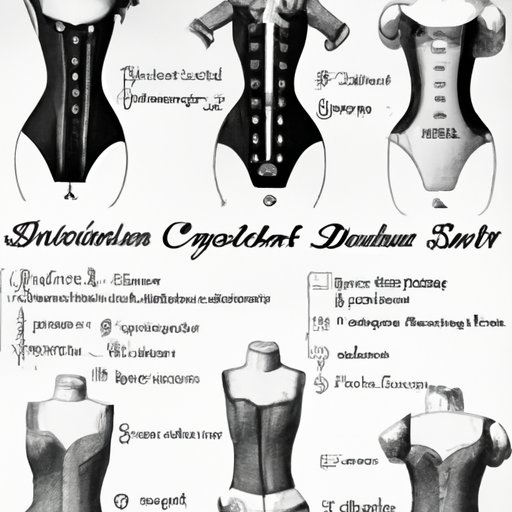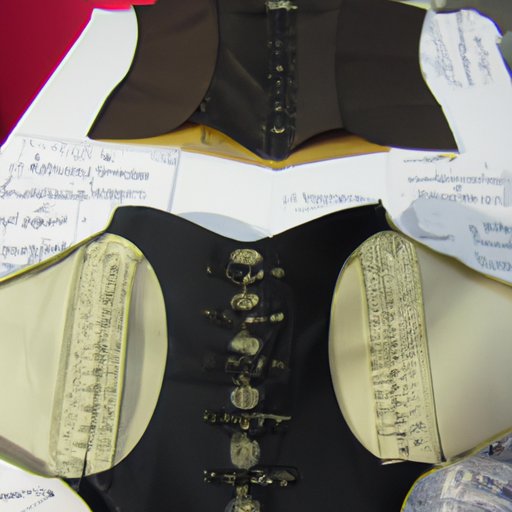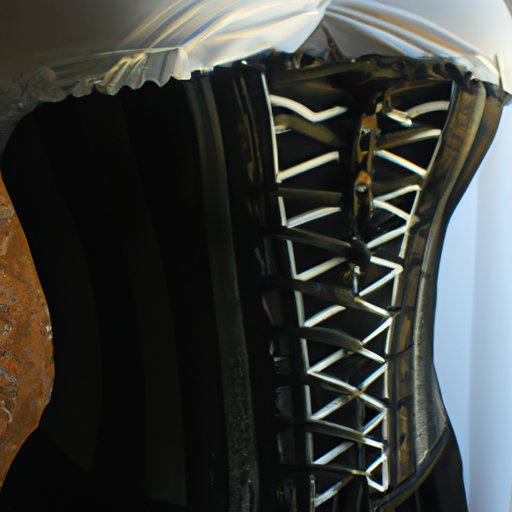Introduction
Corsets are garments typically worn around the torso that are designed to shape the body and bring attention to the waistline. They are often made of flexible fabric or leather and are fastened with laces, buckles, or a combination of both. While corsets are most commonly associated with women’s fashion, they have been used by men in various forms throughout history. This article will explore the history and evolution of corsets, from their original invention to modern trends. It will examine the purpose and use of corsets over time and the impact they have had on society, health, and well-being.

Historical Overview of Corset Development
The earliest known evidence of corsets dates back to ancient times, when Minoan women wore a type of corset-like garment called a “stiffened bodice.” These garments were made of stiffened linen and fastened with straps at the sides. The use of corsets as we know them today is believed to have originated in the 16th century, when they became popular among European nobility. At this time, corsets were made of whalebone, reeds, or other materials and were designed to emphasize the natural curves of the female body.
Over the centuries, the design of corsets has evolved significantly. During the 18th century, corsets grew in popularity among all classes of society, becoming an essential part of a woman’s wardrobe. They were made of more durable materials such as cotton and silk and could be laced up in the front or the back. By the 19th century, corsets had become even more elaborate, with intricate designs and embellishments. At this time, the use of steel boning was introduced, which allowed for a more rigid structure and a greater ability to shape the body.

Examination of the Purpose and Use of Corsets Through History
The primary purpose of corsets has always been to enhance or restrict the body shape. In the 16th and 17th centuries, corsets were used to exaggerate the natural curves of the body and make the waist appear smaller. This trend continued into the 18th and 19th centuries, when corsets were used to create an hourglass figure by pushing the bust forward and narrowing the waist. During this period, corsets were also used to support the spine and improve posture.
In the early 20th century, corsets began to be used for more utilitarian purposes, such as to provide abdominal support during pregnancy or to reduce discomfort caused by certain medical conditions. After World War II, corsets fell out of fashion and were largely replaced by girdles and other undergarments.
Impact of Corset-Wearing on Society
The invention of corsets had a significant impact on societal views of women’s bodies. By emphasizing certain body shapes and discouraging others, corsets helped to reinforce the idea that there was a “right” and “wrong” way for a woman to look. As Dr. Karen Pine, professor of psychology at the University of Hertfordshire, explains: “The corset has been a symbol of control over women’s bodies for centuries. It has been used to restrict movement and enforce an idealised body shape which has changed over time.”
Corsets also had an impact on the fashion industry, inspiring the development of new styles and fabrics. Corsets were often used to show off a woman’s wealth and social standing, as they were often expensive and adorned with luxurious materials. This trend has continued into modern times, with the rise of designer corsets becoming a popular fashion accessory.
Impact of Corset-Wearing on Health and Well-Being
While corsets can be a fashionable and empowering garment, there are potential health risks associated with wearing them. Wearing a corset too tightly can cause discomfort and pain, as well as impair breathing and circulation. Over time, it can lead to weakened abdominal muscles and problems with posture. Women who wear corsets regularly should ensure that they are fitted properly and not excessively tightened.
Other considerations should be taken into account when wearing a corset. For example, it is important to ensure that the corset is made of breathable fabric and is not too tight or restrictive. Additionally, corsets should be worn for no longer than 8 hours per day and should be removed as soon as any discomfort or pain is felt.
Analysis of Modern Corsetry Trends
Modern corsetry has been greatly influenced by past designs, with many contemporary corsets taking on traditional silhouettes. However, there are some distinct differences between modern corsets and those of the past. For example, modern corsets are often lighter and less restrictive, making them more comfortable to wear. Additionally, they are often made of more lightweight materials such as satin or lace, which can be easier to move in.
Popular trends in modern corsetry include bold colors and prints, as well as unusual shapes such as asymmetrical cuts or exaggerated hips. Corsets are also being used to create more daring looks, such as by pairing them with jeans or shorts. With the increasing popularity of corsetry, we can expect to see even more innovative designs in the future.
Conclusion
Corsets have been used for centuries to shape the body and emphasize the waist. Over time, the design of corsets has evolved significantly, from the stiffened bodices of ancient times to the intricate designs of the 19th century. The invention of corsets has had an impact on societal views of women’s bodies, as well as the fashion industry. Additionally, there are potential health risks associated with wearing corsets, so it is important to wear them properly and not for too long. As corsetry continues to grow in popularity, we can expect to see more creative designs in the future.
In conclusion, this article has explored the history and evolution of corsets, from their original invention to modern trends. It has examined the purpose and use of corsets through history and the impact they have had on society, health, and well-being.
(Note: Is this article not meeting your expectations? Do you have knowledge or insights to share? Unlock new opportunities and expand your reach by joining our authors team. Click Registration to join us and share your expertise with our readers.)
